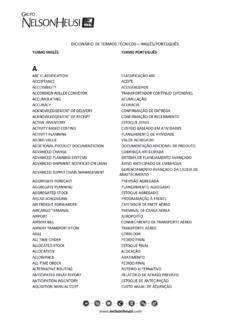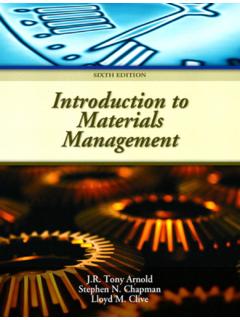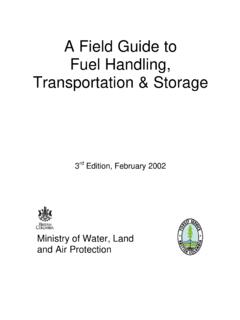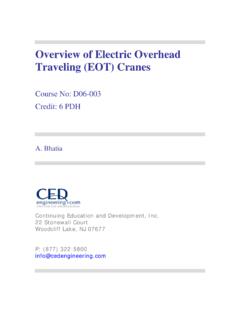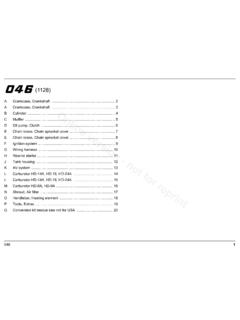Transcription of “What is Theory of Constraints (TOC)?”
1 what is Theory of Constraints (TOC)? Author: Dr Alan Barnard, CEO Goldratt Research Labs A generic Management Problem How do we achieve ongoing improvement within an organization? Every manager, and especially every company owner, wants to ensure that their organization becomes an Ever-flourishing organization an organization that is continuously improving performance and stability, while increasing value to all stakeholders, without ever exhausting resources and without taking significant risks. However, even though it is almost always possible (with the right resources and funding) to improve every part of an organization, even the largest and most prosperous organizations have limited resources and time available to invest in making changes needed to improve their organizations.
2 How do managers know where and when to invest the scarcest resources of their organization (including their own time) to achieve an ever-flourishing organization? To answer this question, managers need a reliable method/mechanism to differentiate between all the MANY parts (processes, policies, skills, capacity) that CAN be improved, from the FEW that MUST be improved in order to achieve more goal units for the organization, now and in the future. The extent of the Problem Every improvement in performance and value to stakeholders results from a change to the organization.
3 However, not every change in the organization will result in an improvement in performance and value. In fact, research shows that the majority of changes (typically 60 80%) initiated by management and owners to improve their organizations do not result in a measureable improvement in the bottom line and a significant percentage of these changes actually deteriorate the organizational performance. These statistics are true for every type of change including mergers & acquisitions, the introduction of new products or services, the implementation of new IT systems, new incentive schemes as well as organizational transformation projects.
4 With such a low success rate, it is no wonder that there is such high resistance in most organizations to new change initiatives and also why there is so much skepticism from owners resulting in most changes not receiving the full investment and/or resource allocation needed. The (major underlying) Cause of the Problem Is it the inherent complexity or not capitalizing on the inherent simplicity? There are typically two opposing views on what the underlying cause(s) of the low success rate of change initiatives are within organizations. The first view relates to an acknowledgement that organizations are very complex and that there are high levels of uncertainty related to identifying the underlying root causes of poor performance or necessary conditions for success and to predicting the impact of such changes on the performance of the organization as a whole.
5 Those managers that ascribe to this view will focus mainly on reducing the complexity and uncertainty by breaking the organization or problem up into simpler parts (where the cause-effect relations are more known/certain) and then aiming to improve or optimize each of the parts. The assumption being that the sum of these local improvements will equal the improvement for the organization as a whole. they assume that More (performance in each part and more initiatives) are always better, especially considering the uncertainty in success rate. The second view acknowledges that all complex systems (like organizations) are governed by inherent simplicity that the majority of problems/poor performances are caused by very few underlying causes (Pareto principle) the leverage points in the system.
6 This Theory acknowledges that a system s performance improvement is not equal to the sum of ALL local improvement, but simply the result of improvements of only those FEW parts not performing at the level of good enough to support the current target for win:win:win goal units. The second view (based on an holistic approach) acknowledges that in the same way that the strength of any chain is limited by the strength of the weakest link, the performance of any organization is limited by the performance of the system constraint (the organization s weakest link). Improving any of non-weakest links will not improve the organization while improving the weakest link will always result in an improvement to the organization as a whole.
7 This holistic approach also acknowledges that people only resist change when a change is considered a lose for them or other stakeholders and also that a win:lose between stakeholders in an organization, will always deteriorate to a lose:lose. Ensuring that changes will be a win for all stakeholders is the key to turning resistance to change, into active contribution and commitment to successfully implement the right changes. Need for a Holistic Focusing Process How do we know where to focus our efforts to improve? In the 1980 s, an Israeli physicist, Dr Eli Goldratt, started applying the mindsets and methods of the hard sciences to the soft science of managing and improving organizations.
8 He realized that the performance of organizations are limited by a system constraint (the weakest link) and that this (insight) can provide the necessary focusing mechanism for all levels of management to differentiate between the MANY parts within their area of responsibility that CAN be improved from the FEW that MUST be improved to help the organization achieve more goal units for all stakeholders. This focusing process should enable each part of an organization to identify not only what that part must START doing to contribute to the improvement of the whole organization but also (more importantly) what that part must STOP doing that is not contributing to or in some cases, in conflict and therefore damaging the performance of the organization as a whole.
9 Goldratt also realized that such a focusing process needs to be supplemented with the necessary holistic thinking tools (TOC Thinking Processes) and decision support system (Throughput Accounting) to develop and capitalize on the cause-effect relationships between the constraint and non- Constraints , which govern the system. Dr Goldratt called this new body of knowledge the Theory of Constraints or TOC. TOC s five focusing steps to analyze and improve any organization holistically included: Step 1: Identify the System Constraint (to achieving more Goal units for the organization) Step 2: Decide how to exploit (not waste) the system constraint Step 3: Subordinate everything to the above decision Step 4: Elevate the System Constraint Step 5: If in a previous step a constraint was broken, don't let inertia become the system constraint, go back to step 1.
10 Over the past 30 years, Dr. Eli Goldratt, the creator of Theory of Constraints , together with an increasing pool of TOC practitioners, implementers and academics have created a vast body of knowledge of how to apply the five focusing steps to different types of organizations from different industries and to different parts of the organization (operations, finance, supply chain, projects, sales, marketing and managing people), and also developed a holistic decision support framework (Throughput Accounting) and a set of logical Thinking Processes and Management Skills that can be applied when organizations are stuck on one or more of the above steps.
